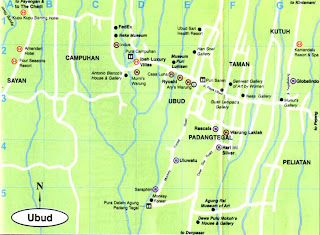


Location
The villages of Kintamani and Penelokan provide a great view of the still active Mount Batur and its fantastic lake. Seven miles in diameter and sixty feet deep, Batur caldera is simply astounding. From Penelokan, take the road Kedisan on the shores of the lake where boats can be rented to cross over to Trunyan. The spectacular mountainous region around Kintamani with its deep Crater Lake and bubbling hot springs, make this region a must to visit. Batur Lake is the largest lake in Bali and the region offers some of the most spectacular views to be found anywhere on the island. Batur Lake also provides water for an underground network of streams and springs across the southern slopes of the mountain. Kintamani is really great for day trips, trekking or simply for getting away from it all for a few days.
The district is the earliest known kingdom in Bali, dating from the tenth century. The evenings get cool up here but it's well worth the stay overnight to climb the volcano and watch the sunrise. Many cheap cottages are available here.
Kintamani can run through Payangan or from Denpasar through the Sangeh monkey forest, Plaga and Lampu, arriving to the north of Kintamani. Bemos to Kintamani are available from Ubud via Sakah (notable for its huge "Baby" statue). They also run via Tampaksiring and Bangli. From Denpasar bemos leave for Kintamani from the Batubulan terminal until late afternoon.
Tour to Kintamani is a very impressive experience where Kintamani Area have very beautiful panorama located in plateau and also encircled by mountain atmosphere with the windblast from Mount Batur. Carpet of Batur Lake seen far below and also there are local resident house beside of Batur Lake. Beside of that, Mount Batur which to date still be active growing its beautiful for Kintamani Area.
Kintamani Tour
After watching the 'Barong Dance', we will stop at Tohpati, the center of Balinese hand weaving and hand made Batik process.Then visit Celuk, with a center of gold and silver work. Original designs in delicate filigree make Balinese jewelry one of the most unusual styles in Asia. Although individual pieces are elaborate, they have simple origins in their making. Artisans use a tree stump with a protruding iron spike as a pounding base, a bamboo stem to catch the fillings, and a manually operated gas pump for heat. As the most of the Balinese crafts, gold and silver work is a hereditary trade. Apprentices begin young, by the time the boys are twelve, they are already producing fine ornaments from the precious metals. and then Mas Village, according to mythology, Pedanda Sakti Bahu Rauh, the first Hindu priest who come to Bali, settled in this village. Many of the Brahmans concentrated in Mas claim descent from this famous priest. In the 13th century, the founders of the village built a large temple to please the ancestors.
The Brahman class became so influential that the whole community came to share in the festivities of the temple, as they are still do today in Pura Taman Pule built up on the same site. In the olden days, the fine arts of woodcarving and painting were reserved exclusively for the royal and religious purposes. Nowadays, they are also produced for fun and commerce. Men of every caste are artisans and the particularly talented live in Mas. Don't be surprised when you visit an art shop to find a core of wood carvers busy making statues, a carver select his seasoned block of timber, then shapes the rough from with an axe. With mallet and dozens of small chisels, the carving is incised with ornaments, and finally smoothed. The sculptors begin young. The most expressive carving is often done by boys of twelve years. As a craftsman says: "young boys have no worries in life, they just carve". Afterwards ,we will visit Bedulu,(elephant Cave), was once the capital of a great kingdom with a semi-mythical pig-headed king, Dalem Beda-Hulu. The legend relates how Beda-Hulu possessed magical powers. He used to sit and meditate, removing his head to reach the beyond. On one such occasion, an unnatural disturbance occurred and the king was forced to get a new head quickly. A pig happened by and its head was taken to place on then neck of the king. Thereafter the king was forced to sit on a high throne and forbade his subjects to look up at him. Beda-Hulu means " he who changed head". PURA SAMUAN TIGA: temple of the meeting of the three. The name is possibly a reference to the Hindu trinity, or it may refer to the meetings held here in the early 11th century.
Kintamani Village
Not far away from Bedulu there are the Yeh Pulu reliefs and Goa Gajah.
GOA GAJAH: the famous "Elephant Cave". It overlooks the Petanu River and consists of a Siwaitic rock-cut cave, a bathing place, a monks' chamber, a number of Buddhist rock-cut stuppas and statues, and several foundations. It is known as the 11th century Buddhist hermitage.
YEH PULU RELIEFS: chipped away from the sheer rock face, the 25-meter-long series of Yeh Pulu carvings are said to date back to the 14th century. The reliefs are in naturalistic style. Legend has it that the great giant architect-general, Kebo Iwa carved out the enchanting picture-shape of village life and animals, which are interspersed with Balinese Hindu gods, with his fingernails.You will also visit Kintamani consisting almost entirely concrete buildings with rusty corrugated iron roofs, it isn't particularly appealing and it is too far north from the rim of the crater for the best views of the lake Batur. It is famous for its breed of furry dogs and the huge outdoor market held every three days.and have lunch there to enjoy the view.
On the return journey to hotel, you will be taken through Tegallalang, where rice terraces are naturally arranged in a geometric, magnificent settings.













